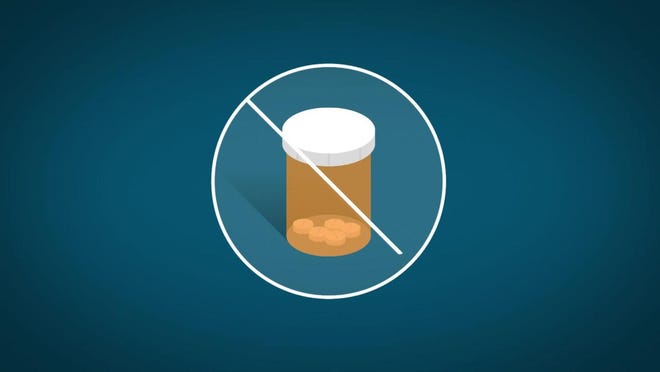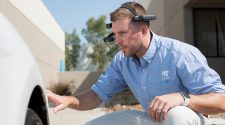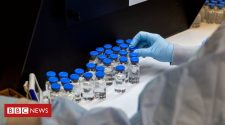Tech these days is often accused of encouraging forms of addiction, but emerging “cyborg” technology may offer an answer for treating the opioid epidemic. Embedding microchips in the brains of addicts could help to, essentially, rewire them.
Gerod Buckhalter is an opioid addict. He’s among millions of people in America affected by what has become a national plague that kills hundreds each day. He hopes, though, that the computer chip in his brain can break him from addiction’s hold.
His dependence took hold after he dislocated his shoulder when he was 15. Dose after dose of the Percocet he was prescribed for pain post-surgery eventually graduated to heroin.
“In my eyes, my family didn’t know how I truly felt,” says Buckhalter, who is now 33 years old. “I felt like I wasn’t harming anybody, so why should anyone care what I’m doing?”
Although it wasn’t what he expected, a group at the Rockefeller Neuroscience Institute did care.
In November, the university launched a clinical trial using deep brain stimulation for patients suffering from treatment-resistant opioid use disorder. The former high school football star became the nation’s first patient.

Cyborg tech to treat addiction
This type of treatment, known as pacemaker technology, has been used previously to treat heart failure and epilepsy. It’s also known for its “cyborg” approach, or use of embedded technology in human beings, to help treat patients.
The clinical trial aims at regulating parts of the brain responsible for leading opioid abusers to seek the drug. These reward centers often get worse over time as the brain becomes chemically imbalanced due to addictive substances. Some of the changes involve a lack of self-control and an increase in anxiety.
In hopes of restoring this balance, the trial is using brain implants to send electrical signals to the brain. A microchip is placed in the brain and connected to a battery under the collarbone. The electrical signals sent via the microchip work to restore dopamine, the hormone responsible for a patient’s drug craving, to a level that’s regulated according to the individual needs of the patient.
What’s involved? The procedure begins with a small skin incision in the front part of the head and then a small opening of the bone. Through that opening in the skull, doctors place the stimulating wires in the reward centers.
Home Depot faces Twitter backlash:Blames opioid crisis for recent rise in store thefts
That 2020 recession:Could we dodge it?
“We’re not advocating for the use of brain implants in patients,” said Ali Rezai, the lead investigator of the clinical trial. “This is for people who have failed everything.”
Other types of technologies considered “cyborg” include studies that use pacemakers to stimulate the heart with electrical impulses to maintain a healthy heartbeat.
Considering the term was coined by two NASA researchers in the 1960s regarding a cybernetic organism that could adapt to space travel, the term has skewed from its original perception. Manfred Clynes and Nathan Kline first defined a cyborg as a ‘self-regulating man-machine’. That snowballed into movies, books and televisions shows that feature more advanced versions of half-human-half-robot fictional characters.
Rezai says he doesn’t consider the experiment as one with cyborg properties since their goal isn’t aimed at augmenting human beings. Others beg to differ.
“Since this trial is combining living matter with intelligent materials, this could be considered a ‘cyborganic’ approach,” says Gorka Orive, lead author of “A New Era for Cyborg Science Is Emerging: The Promise of Cyborganic Beings.”
The pharmacist discards any ethical dilemmas that could be attached to the experiment because it’s viewed as a last resort treatment.
Likewise, Gregory Kaebnick, medical ethicist and editor at The Hastings Center, says that although he finds this robotic approach calls humanity into question, there are other ethical dilemmas to consider.
“The bigger issues for me would be the risk-benefit trade-off for the patient and the scalability,” Kaebnick says. “It’s a little hard to see how a massive public health crisis can be effectively addressed by implanting electrodes in people’s brains.”
The ethicist addressed the fact that, even if the trial is successful, who would be able to pay for this treatment? The procedure could cost up to $75,000.
“The problem is particularly afflicting poor people, who have little access to health care in the first place”, he said. “There’s no chance this is going to be an effective way to respond to the broad, societal epidemic.”
Rezai emphasized that pacemaker technology is a more advanced approach to treat patients undergoing behavioral issues, such as those brought on by drug addiction. Similar technology has shown to be successful when treating depression, evolving from the once commonly used treatment known as shock therapy.
“Instead of a shock treatment sending large, electrical impulses to the brain, this one sends small, programmed signals into the reward area,” Rezai says.
Philosophical concerns
Others seem to oppose it for reasons that call the human psyche into question.
“This is philosophically worrisome to me,” says Judy Grisel, professor of psychology and neuroscience at Bucknell University. “We’re perpetuating the idea that addicts have no choice and never will. The only way we could do this is to take their brain offline.”
Self-care:Why these doctors prioritize mental health when treating patients
Grisel does credit the trial for applying safer measures with electrodes, compared to experiments in the past aimed at reducing addiction. Around 15 years ago, physicians in China would destroy the parts of the brain responsible for drug cravings, leading the country to eventually ban the procedure.
So far, Buckhalter thinks this is one of the best things that has ever happened to him.

“Nothing robot about me,” said the former football player. “How could anybody not think that this is a great thing?”
For Buckhalter, this was a last resort, and it showed him how powerful addiction can be. He’s only started the treatment in November, but says it already feels like it has exceeded his expectations.
“When they turned the stimulator on to test it, I could feel the effects,” he said. “My cravings dropped, I felt calm, felt happy, feelings that I hadn’t had in years since before I started using drugs.”
To be clear, the trial is still at its early stages, and the treatment is not a quick fix. The lead investigator suspects that if these efforts bring successful results, Buckhalter might have to wear the pacemaker for years in the long-term.
And, for him, the embedded technology is part of a holistic approach to addressing his addiction. Besides undergoing this experimental treatment, he’s also using medication and attending behavior and psychological group therapy.
“I was waiting for the next type of treatment to come out, and I was fortunate enough to be one of the ones to get this done,” he says,













